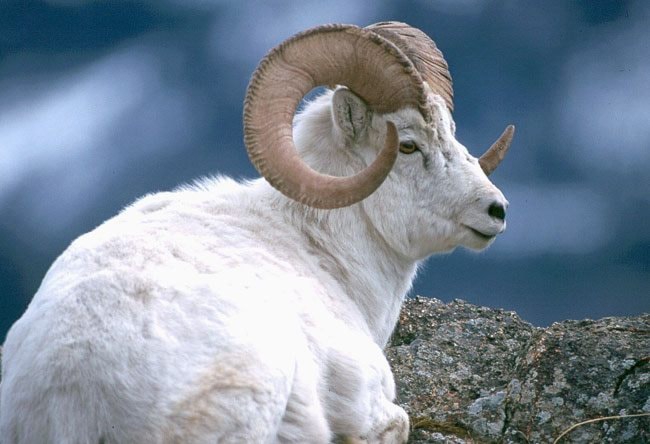"The US National Aeronautics and Space Administration is interested not just in what's going on in outer space, but they also want to use their satellites to understand what's going on on Earth," says wildlife ecologist and Dall sheep expert Laura Prugh.
On August 31 NASA announced ABoVE, a 10-year program designed to examine the effects of a changing climate on the western Arctic. The Arctic Boreal Vulnerability Experiment is a major investment for NASA’s Terrestrial Ecosystem program, says Prugh.
“They’re interested in using their aerospace technology to the fullest, and that means turning more attention to our own planet,” she says.
Specifically, ABoVE will take a prolonged and close look at 6.4 million square kilometres of Alaska, northern Yukon and western Northwest Territories. The plan is to determine what exactly is happening to ecosystems and inhabitants of a warming North, such as Dall sheep.
Prugh, an assistant professor of quantitative wildlife sciences at the University of Washington’s School for Environmental and Forest Services, is the leader of what she calls “the Dall sheep team.” It’s made up of academics, government scientists, and representatives from organizations such as the Gwich’in Renewable Resources Board. Together, they are responsible for one of the 21 projects selected by NASA this year for the first phase of the three-phase ABoVE.
For the next four years, Prugh and her colleagues will monitor Dall sheep, Ovis dalli dalli. Dall sheep have lived in North America at least since the Pleistocene, sharing Beringia with caribou, moose, black-tailed deer and musk oxen among other still-existing species, as well as with creatures that have since gone extinct, like mammoths.
This sheep species will be “the canary in the coal mine,” says Prugh of her survey subjects. The large herbivores need year-round access to forage, yet they are restricted to small population pockets on mountaintops and therefore especially vulnerable to changes in climate, forage species, predator populations and snow conditions in their limited habitats.
“Overall, the Dall sheep project is about a very neglected part of the world: alpine ecosystems,” says Prugh. Research has tended to focus on lower, more accessible elevations.
The health of the sheep populations reflects the health of their habitats - and ultimately the ability of the Far North to continue to function as a driver of such essential global processes as the carbon and water cycles.
“There have been declines in Dall sheep populations throughout their range,” says Prugh. “In some areas they’ve had declines of up to 70 per cent.”
Like the other ABoVE teams, the sheep team is looking at some very fundamental habitat issues for boreal life: temperature fluctuations, snow-pack density and icing events, and habitat changes such as shrub expansion.
Migration of shrubbery up into the warming alpine slopes is a threat, and not only because shrubs edge out forage species preferred by sheep. Browsers like moose and hare follow the shrubs into the alpine. Behind those prey species come wolves and coyotes. Wolves prey on adult sheep, coyotes on lambs. The predators, more visible on the alpine meadows, can conceal themselves in the shrubs and are able to work their way ever closer to the sheep before being spotted.
Meanwhile, ice and snow conditions are affected by changing temperatures. For example, warming can produce winter rain events and periods of thawing and refreezing. One result is a layer of hard-to-penetrate ice between sheep and their forage. Precious energy is lost trying to break through ice.
Another urgent focus of the Dall sheep project is snow conditions, says Prugh. Her team will undertake ground-based work in the Wrangell-St. Elias National Park and Preserve in collaboration with the Alaska Department of Fish and Game and the US National Park Service. “That will give us nice information on Dall sheep movement and habitat use,” she says. “And we’re going to be doing some ground-based measurements on snow depth and hardness and trying to identify icing events.”
This ground work should lead to a flexible model of snow pack properties. “That’s really lacking. From satellites it’s pretty easy to determine the areas covered by snow, but not so easy to determine snow depth and hardness,” says Prugh.
“We’ll take measurements on the ground - and combine them with satellite imagery and weather data about wind and temperature. We’ll basically try to model what the snow depth and hardness should be in these conditions. Then we can check our predictions against what the snow-depth actually was.”
Canadian collaborators, who are providing historical general survey and harvest data, have also offered to participate in snow-condition work on their own side of the border; this will help expand the range and effectiveness of the model, Prugh says.
If the overall “ground-truthing” process supports the effectiveness of the model, it should be possible for scientists to determine alpine conditions in the future by simply plugging the latest climate data and satellite imagery into the model.
“Our focus for the first four years is historic trends and current populations,” she says. If her project is funded for the second phase of ABoVE, Prugh plans to peer further into the future.
“A big question is, if current trends in snow and habitat continue in the next 50 years or so, what kind of changes can we expect to see in Dall sheep populations?” The answer should help with more proactive and effective wildlife management planning, says the biologist.
And a closer look at alpine ecosystems may provide answers to even larger questions. How will major changes in the Far North affect the planet as a whole, including us?
This column is co-ordinated by the Yukon Research Centre at Yukon College with major financial support from Environment Yukon and Yukon College. The articles are archived at www.yukoncollege.yk.ca/research/publications/your-yukon
